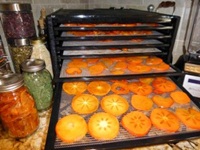
Despite spring’s arrival today according to the calendar, it feels like the new growing season is a ways off, and the first hints of fresh produce are just now beginning to sprout up from the earth. But there is plenty of last season’s harvest preserved and ready for use thanks to the fresh veggies that were dried, stored, or even fermented before winter cut short the last garden’s production.
A variety of kitchen appliances helped me to stretch and preserve the garden’s bounty; from a juicer that is great for juicing winter greens and root crops, to the food processor that quickly prepped cabbages and other veggies for kraut and ferments, to the high-speed blender that can process beans, nuts, and seeds into a range of nut butters, sauces, dips, and hummus dishes to help bridge the garden’s production gap from winter till spring.
A Kitchen Appliance Perfectly Designed for the Backyard Gardener

Excalibur Dehydrator 300×225 Preserving the Harvest with a Food DehydratorBut the kitchen device that I get the most use out of throughout the year has to be the Excalibur Dehydrator (affiliate); and from summer through the fall season it is usually running almost non-stop to preserve organic fruits and veggies from the garden and bulk purchases obtained from other local sources.
I’ve never gotten seriously involved with canning the harvest, I’m not thrilled about freezing fresh produce, and am just beginning to explore the range of options related to fermenting, but dehydrating food is something that has increasingly appealed to me as I’ve gained experience and tried it with more and more of my backyard garden crops.
Food Preservation Doesn’t Get Any Easier than This
Out of all the methods of food preservation that I’ve worked with, drying has been the simplest and easiest to do. It may also be one of the oldest methods for preserving foods and can be accomplished with nothing more than fresh produce and energy from the sun. Of course a little electricity and a modern-day dehydrator will make things go even easier and quicker!
After starting out with a small inexpensive dehydrator I upgraded to a larger Excalibur Dehydrator with its spacious trays, thermostat control, and a timer that makes it a snap to go from fresh produce to dried goods in a matter of hours. I usually use the lower temperature settings when drying in order to preserve the most enzymes and nutrients from the food.
Perfect Choices for Drying Fresh Garden Produce

There isn’t much in the vegetable garden or fruit orchard that you cannot dehydrate. Fruits, leafy greens, herbs, root crops, Dried Peppers and Shrooms 300×225 Preserving the Harvest with a Food Dehydratorflowers, berries, and vegetables can all be dried to preserve and store them for future use. I’m still trying out different techniques and processes for dehydrating and preserving produce but so far my favorite use of all has been to dry leafy green vegetables.
Kale, collards, mustard, arugula, parsley, and celery leaves all dry perfectly and quickly. Herbs such as basil, sage, lovage, dry even faster, and even edible weeds like dandelion leaves, plantain, and lambs quarters can be easily dried. And it’s easy to uncover new ideas such as this comment from Mellissa related to dehydrating okra, something that I hadn’t thought of but will be sure to try!
A Nutritionally Dense Mix of Dehydrated Greens
I like to take an assortment of leafy greens which are combined, dried in the dehydrator, crushed by hand into parsley-like flakes and then sealed in air-tight mason jars. The resulting combination of dehydrated greens is perfect for delivering the healthful nutrients of greens, the flavors and aromatic qualities of the herbs, and the unique properties of the edible weeds and wild plants to the kitchen year-round.
I couldn’t even guess at how many pounds of fresh greens are condensed and packed into each quart jar but it is a substantial amount and provides the satisfaction of continued enjoyment of the garden’s bounty long after the growing season has ended. The dehydrated greens can be added to soups, used in smoothies, sprinkled onto tossed salads, or be added to steamed vegetables and other dishes as they are cooking.
Enjoying the Satisfaction of Gardening Long after the Garden is Done

Dehydrated Produce 300×225 Preserving the Harvest with a Food DehydratorThen there are the jars of dried hot peppers, eggplant, squash, tomatoes, beans, peas, ginger, and other dried produce that line the pantry shelves and decorate the kitchen counters. I’ve even considered the possibility of the dried veggies serving as an emergency source of seed and plan to test some of the seeds inside of the dried peppers and squash to see if they are viable and will still germinate.
That’s why the dehydrator may not just be my favorite kitchen appliance… it may just be my favorite gardening tool as well. I can hold a jar of dehydrated veggies or mixed greens in my hands during the middle of winter and experience the same satisfaction, appreciation, and rewards of gardening as I did during the peak of the summer’s growing season!
Source: Veggie Gardening Tips – Preserving the Harvest with a Food Dehydrator





